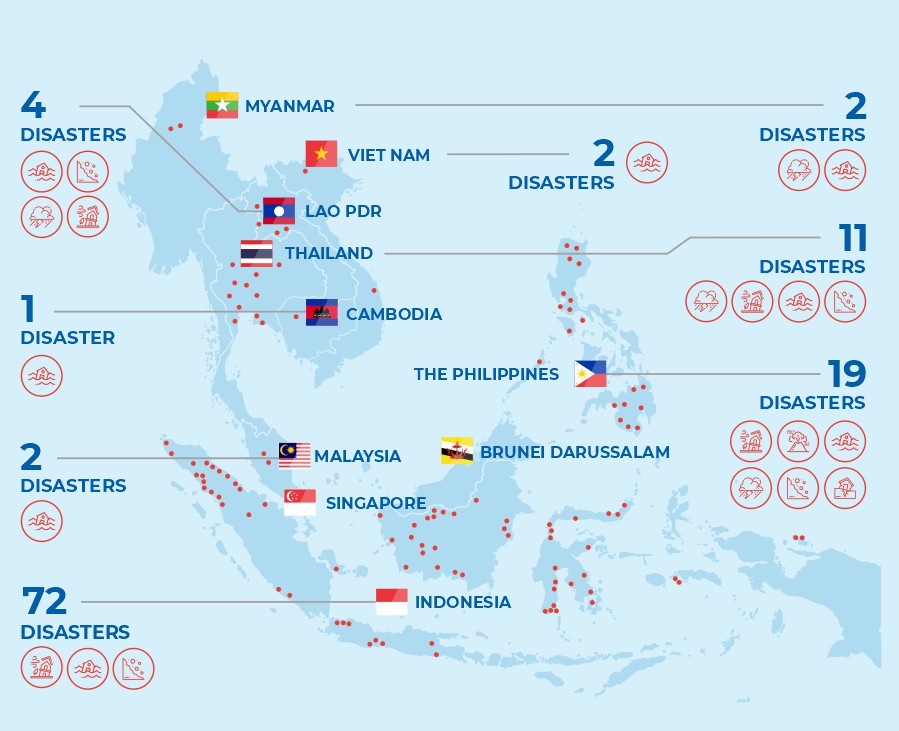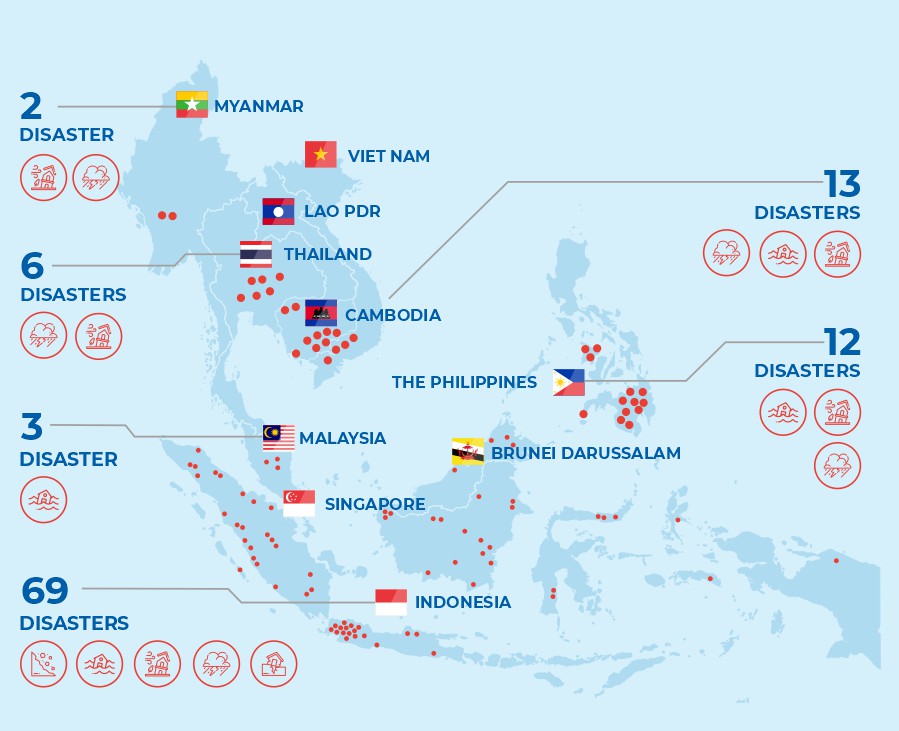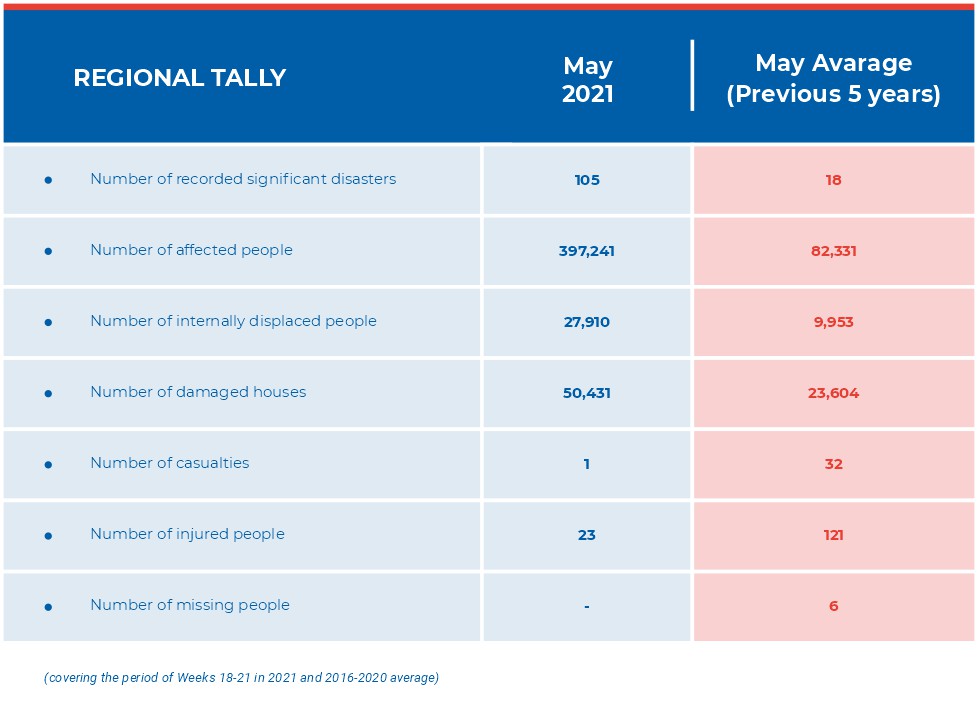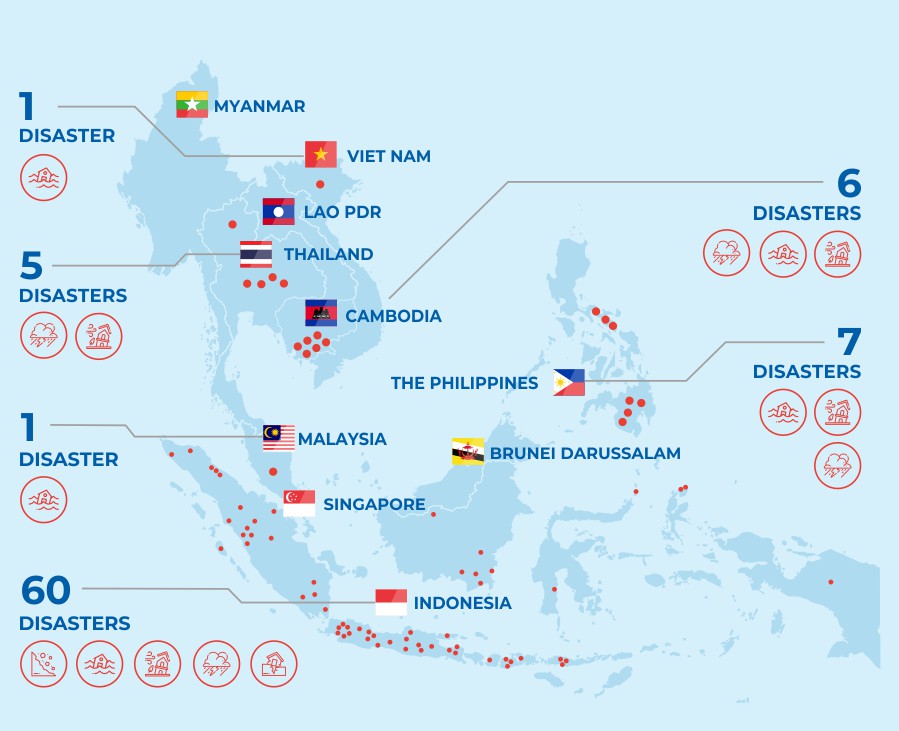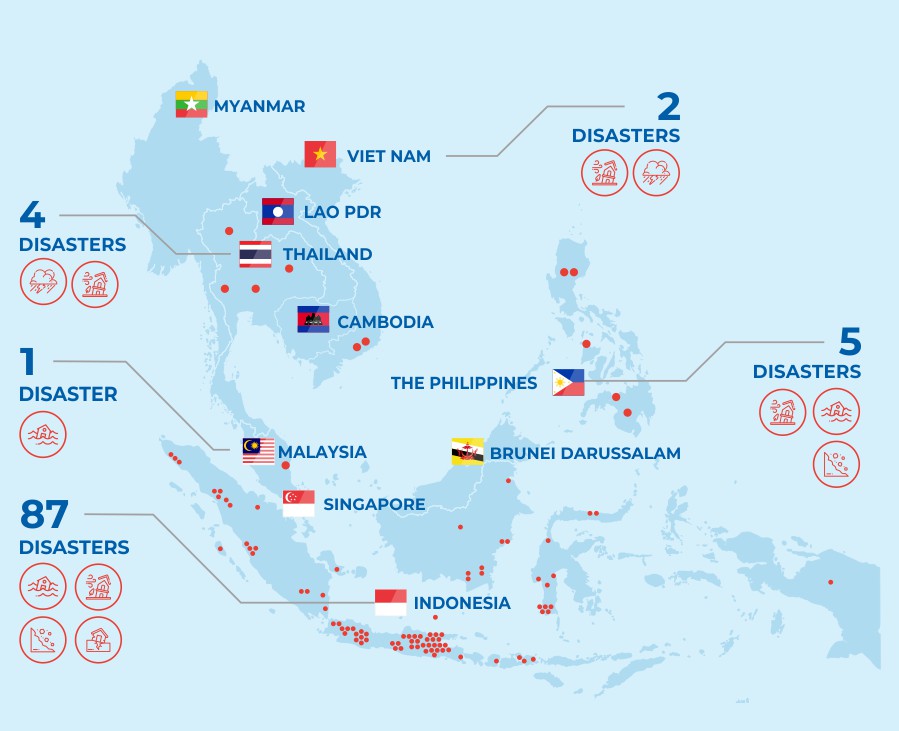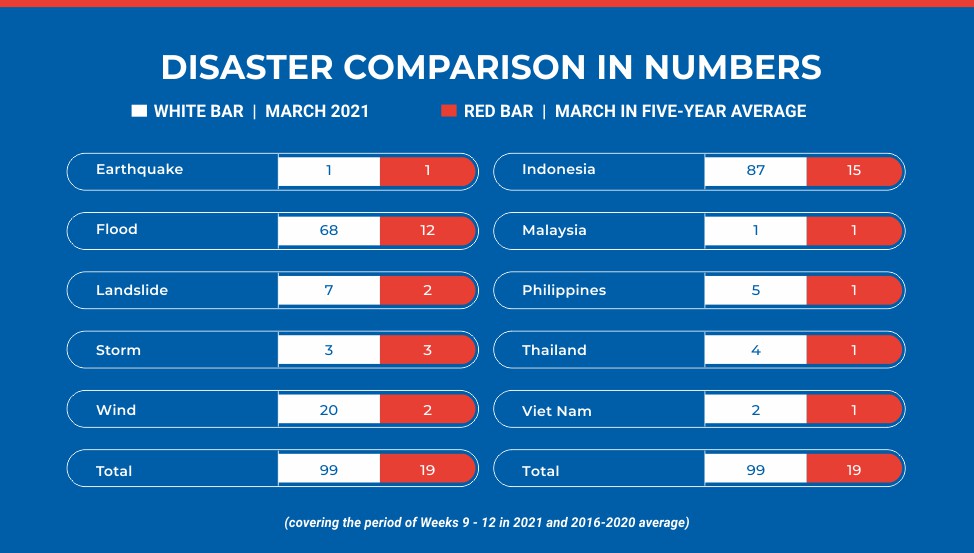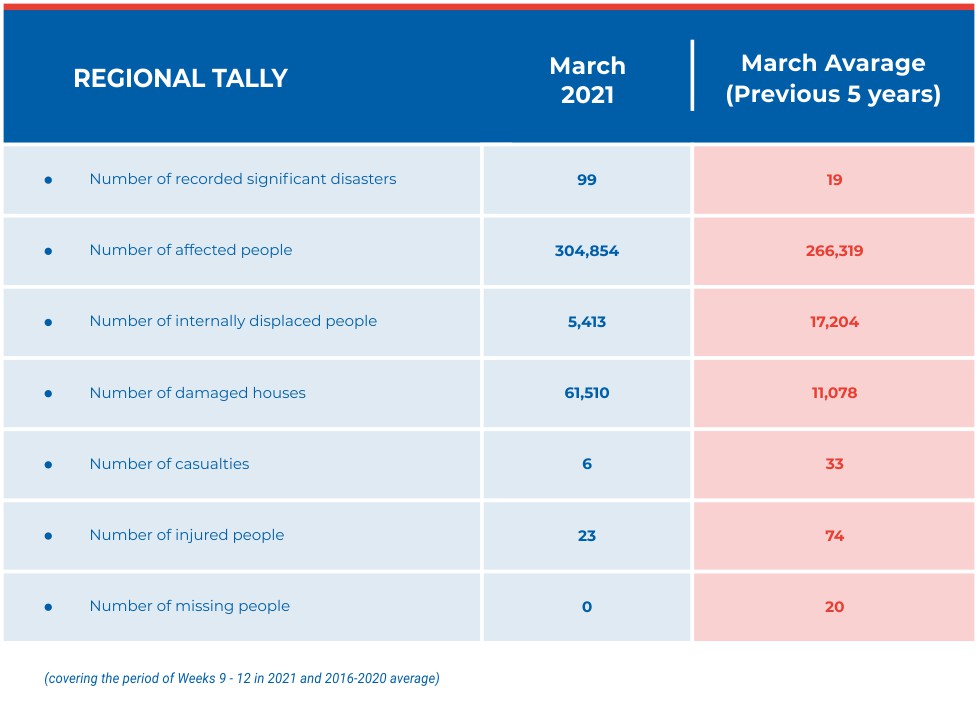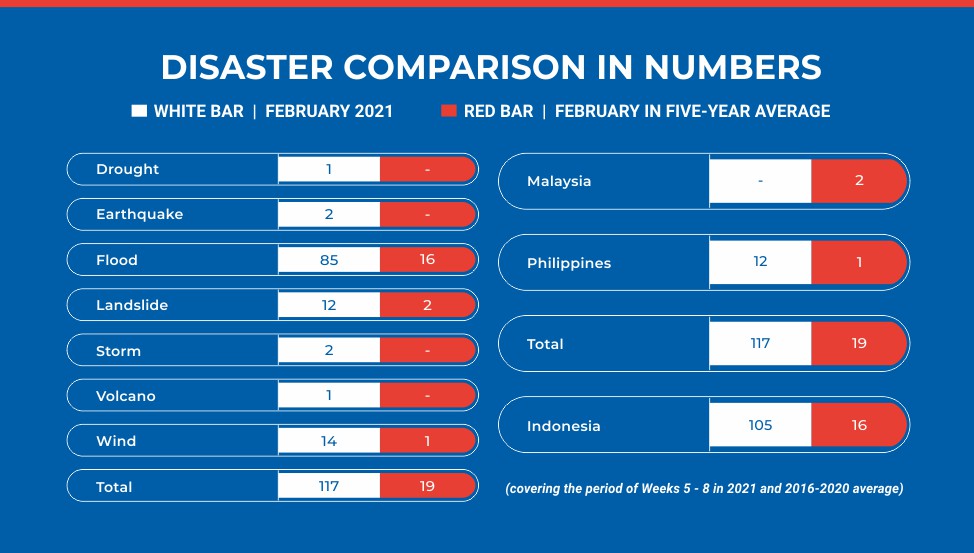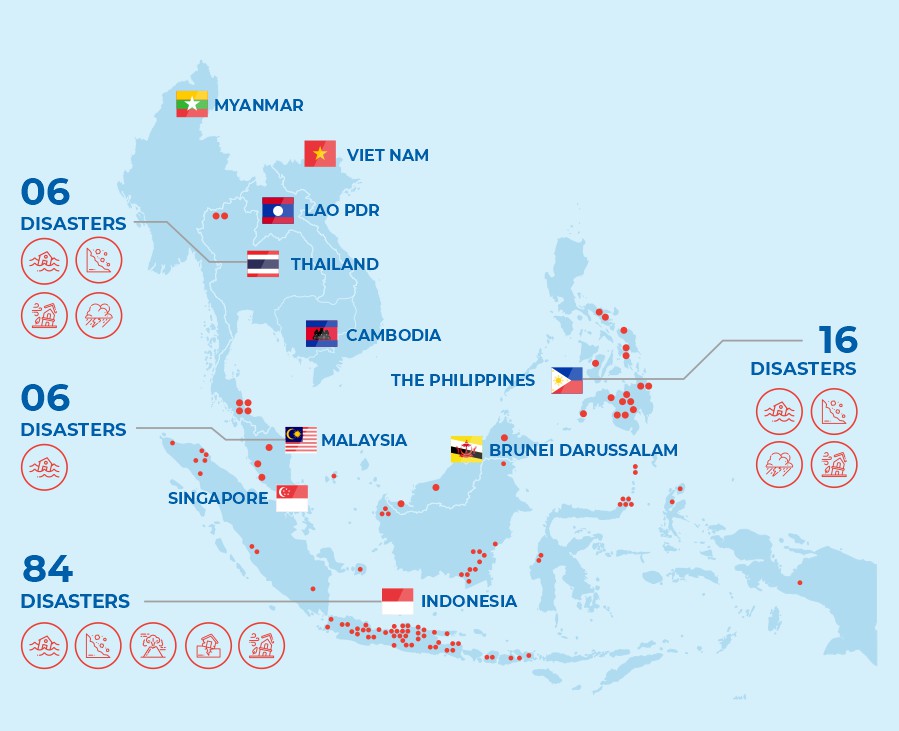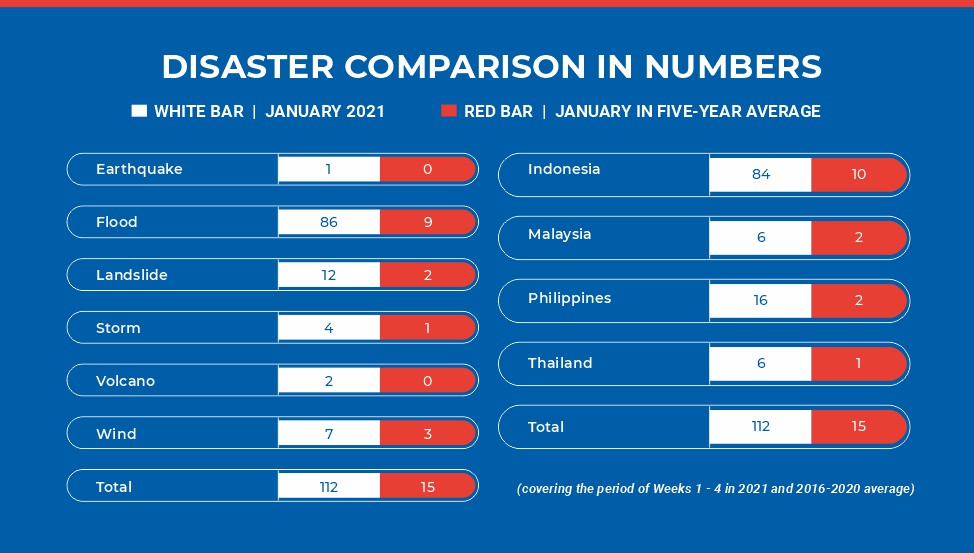Vol 76 – MONTHLY DISASTER REVIEW AND OUTLOOK

MONTHLY DISASTER REVIEW AND OUTLOOK
AUGUST 2021 | DISASTER MONITORING & ANALYSIS
(DMA) UNIT, AHA CENTRE
GENERAL REVIEW OF AUGUST 2021
For the month of August 2021, a total of 72 disasters were reported. The ASEAN Member States that were affected were Indonesia, Malaysia, Myanmar, the Philippines, Thailand and Viet Nam. Most of the disasters (72.22%) occurred in Indonesia and comprised nearly half, 45.08%, of the total number of affected people for the month. The share of the disaster-affected people for other ASEAN Member States was as follows: (1) Malaysia-0.07%, (2) Myanmar-0.03%, (3) Philippines-0.13%, (5) Thailand-53.57% and (6) Viet Nam-1.15%. August 2021 saw disasters affecting 92 per 100,000 people* and displacing 1 per 100,000 people* in the region, three times and 57 times fewer than the previous month, respectively. August 2021 accounted for 9.59% of the total disasters reported so far in the current year.
Most of the disasters that occurred in August 2021 were floods (70.83%) and this is consistent with August of the previous year and August on a five-year average (2016-2020). August 2021 saw hydrometeorological disasters (droughts, floods, rain-induced landslides, storms and winds) dominating the disasters that affected the region for the month (98.6%). The reported disasters in the region for August 2021 in comparison with the historical data (average for August 2016-2020) indicates that there were 2.88x more reported disasters; 3.25x fewer people affected; 29.18x fewer people displaced; 3.24x more houses affected to some extent; 2.89x fewer lives lost; 25.17x fewer people suffering injuries; and lastly, 18.5x fewer people reported missing.
Geophysically, 29 significant earthquakes (Magnitude ≥ 5.0) were reported by Indonesia’s Badan Meteorologi, Klimatologi dan Geofisika (BMKG), and the Philippine Institute for Volcanology and Seismology (PHIVOLCS). Recent volcanic activity was reported for Ili Lewotolok and Merapi (Alert Level III), Semeru, Dukono, and Ibu (Alert Level II) in Indonesia by the Pusat Vulkanologi dan Mitigasi Bencana Geologi (PVMBG), and Taal (Alert Level 2), Bulusan and Kanlaon (Alert Level 1) by PHIVOLCS. None have resulted in disasters but are continuously being monitored.
*Computed based on 2020 population data from worldometers.com
ANALYSIS
According to the ASEAN Specialised Meteorological Centre (ASMC), compared with the average value from 2001-2020, during August 2021, rainfall was above-average over much of the ASEAN region and below-average over the northeastern ASEAN region. The largest positive anomalies (wetter conditions) were detected over the equatorial region for both satellite-derived rainfall estimate datasets (GSMaP-NRT and CMORPH-Blended). Coincidingly, numerous hydrometeorological disaster events were reported for this area. A disaster (caused by thunderstorms, flooding and landslide), though minor, was reported in northern Viet Nam despite the largest negative anomalies (drier conditions) for the region for August 2021 being detected over the area.
Drought was reported in Cilacap Regency, Central Java, in Indonesia. Based on Figure 2, the equatorial region, along with central and northern Myanmar, experienced near- to below-average temperatures with the warmest anomalies being detected over northern Viet Nam.
SPOTLIGHT
According to the situational report from the Philippines’ National Disaster Risk Reduction Management Council, since 28 July 2021 the Southwest Monsoon has brought intense rains to multiple regions of the Philippines and has since affected 312,605 families (1,222,241 persons) from 1,117 barangays. Related incidents to the Southwest Monsoon that impacted multiple regions in the Philippines were floods, rain-induced landslides, a mudslide, an overflowing spillway and swollen rivers. 129 roads and three bridges were affected and 12 roads and one bridge remain impassable. 1,723 houses have reportedly been damaged. The estimated cost of damage to agriculture is reported to be around USD 4,686,168.51 incurred in Regions I, III, VIII, IX and CAR. With regard to infrastructure, an estimated USD 721,025.94 worth of damage has been reported. A total of 40 cities/municipalities were declared under a State of Calamity. Assistance (in the forms of financial, family food packs, other food items, family kits, hygiene kits, sleeping kits, kitchen kits, medical assistance, non-food items) worth USD 204,497.13 have been provided to victims in Regions I, III, VI, CAR and MIMAROPA.
SEASONAL OUTLOOK
In the coming month, for parts of the ASEAN region north of the Equator, Southwest Monsoon conditions are forecast to continue to persist. The northern ASEAN region will continue to experience its traditional wet season and the southern ASEAN region, its traditional dry season. For October, the equatorial ASEAN region is expected to have increased rainfall during the latter part of the month as the Southwest Monsoon conditions transition into the inter-monsoon period. Southwest Monsoon-associated prevailing winds are expected to blow from the southeast or southwest and gradually weaken and become light and variable in direction during the transition into the inter-monsoon period.
An increased chance of above-normal rainfall over much of the ASEAN region is foreseen for the September to November 2021 period with the highest likelihood over central and southern parts of the Maritime Continent. La Niña-like conditions were detected in August but for the rest of the year, the forecast is still split between ENSO-neutral and La Niña conditions developing. The Indian Ocean Dipole (IOD) is currently in the negative phase and is forecast to return to neutral by November or December 2021. During a negative IOD phase, waters in the eastern Indian Ocean (near Indonesia) tend to be warmer than normal and the southern ASEAN region tend to experience above-average rainfall. Most parts of the ASEAN region will experience warmer-than-usual temperatures from September to November 2021.
Considering the IOD being in the negative phase, the outlook for the equatorial ASEAN region, the outlook for over much of the ASEAN region, and the disaster data records from the ASEAN Disaster Information Network, the number of disaster events (particularly hydrometeorological disasters) and the number of affected persons, are expected to increase in frequency and number, respectively, as the year ends. National Disaster Management Organisations (NDMOs), relevant authorities and agencies and the public are advised to take necessary preparations and actions accordingly.
*Note from ASMC: The qualitative outlook is assessed for the region in general and based on the latest runs from models provided by the SEA RCC-Network LRF node. For specific updates on the national scale, the relevant ASEAN National Meteorological and Hydrological Services should be consulted.
Sources: ASEAN Disaster Information Network (ADINet), ASEAN Disaster Monitoring and Response System (DMRS), ASEAN Specialised Meteorological Centre (ASMC), Badan Nasional Penanggulangan Bencana (BNPB) – Indonesia, Agensi Pengurusan Bencana Negara (NADMA) – Malaysia, Department of Disaster Management (DDM) – Myanmar, National Disaster Risk Reduction and Management Council (NDRRMC) – Philippines, Department of Disaster Prevention and Mitigation (DDPM) – Thailand, Viet Nam Disaster Management Authority (VNDMA) – Viet Nam, Badan Meteorologi, Klimatologi dan Geofisika (BMKG) – Indonesia, Pusat Vulkanologi dan Mitigasi Bencana Geologi (PVMBG) – Indonesia, Department of Meteorology and Hydrology (DMH) – Myanmar, Philippine Institute for Volcanology and Seismology (PHIVOLCS) – Philippines, Philippine Atmospheric Geophysical and Astronomical Services Administration (PAGASA) – Philippines
Written by : Keith Paolo Landicho, Sadhu Zukhruf Janottama, Lawrence Anthony Dimailig
DISCLAIMER
The AHA Centre’s estimation is based on data and information shared by National Disaster Management Organisations (NDMOs) and other relevant agencies from ASEAN Member States, international organisations, and news agencies. Further information on each recorded significant disaster, description, and detail of data and information are available at: http://adinet.ahacentre.org/reports.
- Published in Monthly Disaster Outlook
Vol 75 – MONTHLY DISASTER REVIEW AND OUTLOOK

MONTHLY DISASTER REVIEW AND OUTLOOK
JULY 2021 | DISASTER MONITORING & ANALYSIS
(DMA) UNIT, AHA CENTRE
GENERAL REVIEW OF JULY 2021
For the month of July 2021, a total of 113 disasters were reported. The ASEAN Member States that were affected were Cambodia, Indonesia, Lao PDR, Malaysia, Myanmar, the Philippines, Thailand and Viet Nam. Most of the disasters (63.72%) occurred in Indonesia but these only comprised 13.32% of the total number of affected people for the month. The Philippines comprised 16.81% of the disasters for July but comprised 83.3% of the total number of affected people, largely due to the effects of the Southwest Monsoon with one instance being enhanced by Tropical Cyclone IN-FA. The share of disaster-affected people for other ASEAN Member States was as follows: (1) Cambodia-0.01%, (2) Lao PDR-0.3%, (3) Malaysia-0.02%, (4) Myanmar-2.74%, (5) Thailand-0.15% and (5) Viet Nam-0.14%. July 2021 saw disasters affecting 265 per 100,000 people* and displacing 57 per 100,000 people* in the region. July 2021 also accounted for 16.64% of the total disasters and almost half (49.76%) of damage costs reported so far in the current year.
Most of the disasters that occurred in July 2021 were floods (57.52%) and this is consistent with July of the previous year and July on a five-year average (2016-2020). July 2021 saw hydrometeorological disasters (floods, rain-induced landslides, storms and winds) dominating the disasters that affected the region for the month (79.58%). The reported disasters in the region for July 2021 in comparison with the historical data (average for June 2016-2020) indicates that there were 5.94x more reported disasters; 5.56x fewer people affected; 18.73x more people displaced; 7.73x more houses affected to some extent; 5.77x fewer lives lost; 45.5x fewer people suffering injuries; and lastly, 1.86x more people reported missing.
Geophysically, 38 significant earthquakes (Magnitude ≥ 5.0) were reported by Indonesia’s Badan Meteorologi, Klimatologi dan Geofisika (BMKG), the Philippine Institute for Volcanology and Seismology (PHIVOLCS), and Myanmar’s Department of Meteorology and Hydrology (DMH). On 1 July 2021, Mount Taal in the Philippines was raised to Alert Level 3 due to the volcano generating a dark phreatomagmatic plume 1 kilometre high (with no accompanying volcanic earthquake). The eruption of Mount Taal affected 22,433 people and caused the evacuation of 13,027 from the high-risk barangays of Agoncillo and Laurel in Batangas Province. Mount Taal is currently placed under Alert Level 2 (as of 23 July 2021). Volcanoes in Indonesia and the Philippines have shown recent activity but have not resulted in significant events (except for Mount Taal) and are continuously being monitored.
*Computed based on 2020 population data from worldometers.com
ANALYSIS
According to the ASEAN Specialised Meteorological Centre (ASMC), during July 2021, rainfall in the region was a mix of lower to more than the average values from 2001-2020.(Figure 1.a). Wetter conditions (positive anomalies from average values from 2001-2020) were detected over the coastal parts of southern Myanmar, southern Cambodia, northwestern Philippines, as well as the Maluku Islands for both satellite-derived rainfall estimates datasets (GSMaP-NRT and CMORPH-Blended). Coincidentally, these were the areas where disasters were reported for July 2021 with southern Myanmar and Northwestern Philippines reportedly resulting from the effects of the Southwest Monsoon. The two datasets (GSMaP-NRT and CMORPH-Blended) were also in agreement that the largest negative anomalies (drier conditions) were over the central Philippines. However, there were some discrepancies over the western and central Maritime Continent, where CMORPH-Blended recorded drier conditions than GSMaP-NRT.
SPOTLIGHT
According to the situational report from the Philippines’ National Disaster Risk Reduction Management Council, since 28 July 2021 the Southwest Monsoon has brought intense rains to multiple regions of the Philippines and has since affected 312,605 families (1,222,241 persons) from 1,117 barangays. Related incidents to the Southwest Monsoon that impacted multiple regions in the Philippines were floods, rain-induced landslides, a mudslide, an overflowing spillway and swollen rivers. 129 roads and three bridges were affected and 12 roads and one bridge remain impassable. 1,723 houses have reportedly been damaged. The estimated cost of damage to agriculture is reported to be around USD 4,686,168.51 incurred in Regions I, III, VIII, IX and CAR. With regard to infrastructure, an estimated USD 721,025.94 worth of damage has been reported. A total of 40 cities/municipalities were declared under a State of Calamity. Assistance (in the forms of financial, family food packs, other food items, family kits, hygiene kits, sleeping kits, kitchen kits, medical assistance, non-food items) worth USD 204,497.13 have been provided to victims in Regions I, III, VI, CAR and MIMAROPA.
SEASONAL OUTLOOK
With the monsoon rain band located north of the equator in August 2021, Southwest Monsoon conditions are likely to persist over the ASEAN region. Climatologically, the Southwest Monsoon is characterised by rainy conditions in the northern ASEAN region and dry weather in the southern ASEAN region. During the August to October period, the prevailing winds in the ASEAN region are from the southeast or southwest.
For the August to October 2021 period, there is an increased chance of above-normal rainfall for much of the Maritime Continent. ENSO-neutral conditions are forecast to continue for the next three months. The Indian Ocean Dipole (IOD) is in the negative phase and models are forecasting the negative IOD to also remain for the next three months. A negative IOD tends to bring above-average rainfall for the southern ASEAN region for this time of the year. Warmer-than-usual temperatures are expected for most of the ASEAN region except for Borneo and southern Sumatra where near- to above-normal temperatures are predicted.
Sources: ASEAN Disaster Information Network (ADINet), ASEAN Specialised Meteorological Centre (ASMC), ASEAN Disaster Monitoring and Response System (DMRS), Cambodia National Committee on Disaster Management (NCDM), Badan Nasional Penanggulangan Bencana (BNPB), Malaysia Agensi Pengurusan Bencana Negara (NADMA), Myanmar Department of Disaster Management (DDM), National Disaster Risk Reduction and Management Council (NDRRMC), Thailand Department of Disaster Prevention and Mitigation (DDPM), Viet Nam Disaster Management Authority (VNDMA), Badan Meteorologi, Klimatologi dan Geofisika (BMKG), Pusat Vulkanologi dan Mitigasi Bencana Geologi (PVMBG), Philippine Institute for Volcanology and Seismology (PHIVOLCS)
Written by : Keith Paolo Landicho, Sadhu Zukhruf Janottama, Lawrence Anthony Dimailig
DISCLAIMER
The AHA Centre’s estimation is based on data and information shared by National Disaster Management Organisations (NDMOs) and other relevant agencies from ASEAN Member States, international organisations, and news agencies. Further information on each recorded significant disaster, description, and detail of data and information are available at: http://adinet.ahacentre.org/reports.
- Published in Monthly Disaster Outlook
Vol 74 – MONTHLY DISASTER REVIEW AND OUTLOOK

MONTHLY DISASTER REVIEW AND OUTLOOK
JUNE 2021 | DISASTER MONITORING & ANALYSIS
(DMA) UNIT, AHA CENTRE
GENERAL REVIEW OF JUNE 2021
For the month of June 2021, a total of 53 disasters were reported. The ASEAN Member States affected were Indonesia, Lao PDR, the Philippines, Thailand and Viet Nam. A majority of the disasters (47.17%) occurred in Indonesia which also accounted for 31.23% of the total number of affected people for the month (Lao PDR-7.41%, the Philippines-55.73%, Thailand-4.52%, Viet Nam-0.23%). June 2021 saw disasters affecting 42 per 100,000 people* and displacing 4 per 100,000 people* in the region. June 2021 also accounted for roughly one-tenth (9.36%) of the total disasters and 44.1% of damage costs reported so far in the current year.
Most of the disasters that occurred in June 2021 were floods (45.28%) and this is consistent with June of the previous year and June on a five-year average (2016-2020). Floods for June 2021 impacted only a third (34%) of the total number of affected people with 56.34% affected by tropical cyclone-related hazards (floods, landslides, storms and winds). The reported disasters in the region for June 2021 in comparison with the historical data (average for June 2016-2020) indicates that there were 2.12x more reported disasters; 3x fewer people affected; 8.2x more people displaced; 1.76x more houses affected to some extent; 2.5x fewer lives lost; 1.5x fewer people suffering injuries; and lastly, 3.69x fewer people missing.
Geophysically, 16 significant earthquakes (Magnitude ≥ 5.0) were reported by Indonesia’s Badan Meteorologi, Klimatologi dan Geofisika (BMKG) and the Philippine Institute for Volcanology and Seismology (PHIVOLCS). A Magnitude 6.1 earthquake that occurred 67 km Southeast of Central Maluku in week 24 caused a sea level rise of 0.5m according to the BMKG, damage to 233 houses and three places of worship, and displaced 8,800 persons into 56 evacuation centres. Volcanoes in Indonesia and the Philippines have shown recent activity but have not resulted in significant events and are continuously being monitored.
*Computed based on 2020 population data from worldometers.com
ANALYSIS
According to the ASEAN Specialised Meteorological Centre (ASMC), during June 2021, areas that received above-average rainfall were the western and central Maritime Continent (except Borneo), and northeastern parts of Mainland Southeast Asia. This agrees spatially with the disaster reports for the month of June. The largest positive anomalies (wetter conditions) were recorded over Java and northern Viet Nam (due to Tropical Storm Koguma). The eastern Maritime Continent predominately experienced below-average rainfall except for central parts of the Philippines due to the development of Tropical Storm Choi-Wan.
SPOTLIGHT
Tropical Storm Choi-Wan, locally known in the Philippines as “Dante”, caused flooding and damage mostly in the central Philippines. TS Choi-Wan was the third named storm of the 2021 Pacific typhoon season and originated from an area of low pressure south-southeast of Guam later fuelled by an environment favorable for tropical cyclogenesis according to the JTWC and JMA. TS Choi-Wan made a total of eight landfalls across the Philippines affecting a number of areas of the country from 1 June up until it left the Philippine Area of Responsibility on the 4 June. The storm reportedly claimed 11 lives, caused three injuries, affected 32,800 families (137,900 persons), and displaced 16,000 persons.
SEASONAL OUTLOOK
Southwest Monsoon conditions are expected to continue in July 2021 as the prevailing low-level winds over the ASEAN region strengthen and blow from the southeast or southwest, with the passage of the monsoon rain band further north of the equator in the second half of the month. The Southwest Monsoon season is the traditional dry season for the southern ASEAN region, which typically brings extended periods of dry conditions over the region. For the northern ASEAN region, the Southwest Monsoon is the traditional wet season.
For the July to September 2021 period, models predict an increased chance of above-normal rainfall for most of the equatorial ASEAN region from 8°N to 10°S. ENSO-neutral conditions are forecast to continue for the next three months. The Indian Ocean Dipole (IOD) is close to the negative state and models are forecasting a negative IOD for the July to September 2021 period. A negative IOD tends to bring above-average rainfall for the southern ASEAN region for this time of the year. Warmer-than-usual temperature is expected for most of the ASEAN region except for Borneo and southern Sumatra where near- to above-normal temperature is predicted.
The dry season for the southern ASEAN region is expected to extend from July to October 2021. During these months, isolated to scattered hotspots are likely during dry periods and widespread hotspots can be expected during extended dry periods, which may lead to an increased risk of transboundary haze occurrence. Nonetheless, due to predicted above-normal rainfall for the southern ASEAN region from July to September 2021, a recurrence of a similar 2015 (El Niño year) or a 2019 (positive IOD year) severe haze event is unlikely. Shower activities are expected to persist for the northern ASEAN region during this period, and help to subdue hotspot and smoke haze activities.
Sources: ASEAN Disaster Information Network (ADINet), ASEAN Specialised Meteorological Centre (ASMC), ASEAN Disaster Monitoring and Response System (DMRS), Cambodia National Committee on Disaster Management (NCDM), Badan Nasional Penanggulangan Bencana (BNPB), Malaysia Agensi Pengurusan Bencana Negara (NADMA), Myanmar Department of Disaster Management (DDM), National Disaster Risk Reduction and Management Council (NDRRMC), Thailand Department of Disaster Prevention and Mitigation (DDPM), Viet Nam Disaster Management Authority (VNDMA), Badan Meteorologi, Klimatologi dan Geofisika (BMKG), Pusat Vulkanologi dan Mitigasi Bencana Geologi (PVMBG), Philippine Institute for Volcanology and Seismology (PHIVOLCS)
Written by : Keith Paolo Landicho, Sadhu Zukhruf Janottama, Lawrence Anthony Dimailig
DISCLAIMER
The AHA Centre’s estimation is based on data and information shared by National Disaster Management Organisations (NDMOs) and other relevant agencies from ASEAN Member States, international organisations, and news agencies. Further information on each recorded significant disaster, description, and detail of data and information are available at: http://adinet.ahacentre.org/reports.
- Published in Monthly Disaster Outlook
Vol 73 – MONTHLY DISASTER REVIEW AND OUTLOOK

MONTHLY DISASTER REVIEW AND OUTLOOK
MAY 2021 | DISASTER MONITORING & ANALYSIS
(DMA) UNIT, AHA CENTRE
GENERAL REVIEW OF MAY 2021
For the month of May 2021, a total of 105 disasters were reported. The ASEAN Member States that were affected were Cambodia, Indonesia, Malaysia, Myanmar, the Philippines, and Thailand. A majority of the disasters (64.76%) occurred in Indonesia, which also saw 69.5% of the total number of affected people for the month (Cambodia – 2.1%, Malaysia – 0.7%, Myanmar – <0.1%, Philippines – 26.1%, Thailand – 1.5%). May 2021 saw disasters affecting 60 per 100,000 people* and displacing 4 per 100,000 people* in the region. May 2021 also accounted for roughly one-fifth (20.5%) of the total disasters reported so far in the current year.
The majority of the disasters that occurred in May 2021 were floods (58%) and this is consistent with May of the previous year and May on a five-year average (2016-2020). Flood victims comprised a little over three-quarters (77%) of the total number of affected people. The reported disasters in the region for May 2021 in comparison with the historical data (average for May 2016-2020) indicates that there were 5.5 time more reported disasters; almost 5 times more people affected; almost 3 times more people displaced; twice as many houses affected to some extent; 32 times fewer lives lost; 5 times fewer people suffering injuries; and lastly, 100 times fewer people missing.
Geophysically, 28 significant earthquakes (Magnitude ≥ 5.0) were reported by Indonesia’s Badan Meteorologi, Klimatologi dan Geofisika (BMKG) and the Philippine Institute for Volcanology and Seismology (PHIVOLCS). A Magnitude 6.2 earthquake (later downgraded to M5.9) that occurred 57 km southeast of Blitar in East Java in week 20 caused injuries to two individuals, affected 6,200 persons, and caused damage to thousands of houses, and hundreds of public facilities. Volcanoes in Indonesia and the Philippines have shown recent activity but they have not resulted in significant events and are continuously being monitored.
*Computed based on 2020 population data from worldometers.com
ANALYSIS
According to the ASEAN Specialised Meteorological Centre (ASMC), during May 2021, the largest positive anomalies (wetter conditions) were detected in southern Philippines due to Tropical Depression 03W (local name: Crising). Despite below-average rainfall over the southern Maritime Continent, over half of all recorded disasters that were apparently hydrological in nature (flooding and severe local storms) were reported across Indonesia. A mixture of below and above-average rainfall was observed in Mainland Southeast Asia.
SPOTLIGHT
Over the tropical Pacific Ocean, La Niña conditions declined and returned to El Niño Southern Oscillation (ENSO)-neutral conditions by the beginning of June. The sea surface temperatures in the central and eastern Pacific Ocean continued to warm, with atmospheric indicators (cloudiness and wind anomalies) remaining consistent with the ENSO-neutral conditions. ENSO-neutral conditions are neither El Niño (warming of ocean surface, reduced rainfall in Indonesia) nor La Niña (cooling of ocean surface, increased rainfall in Indonesia), which are the extreme phases of the ENSO cycle.
SEASONAL OUTLOOK
According to the ASEAN Specialised Meteorological Centre (ASMC), through May 2021, the monsoon rain band continued to move northwards over the northern ASEAN region. Concurrently, the prevailing winds over most of the southern ASEAN region strengthened to blow mainly from the southeast or southwest, in line with the transition to Southwest Monsoon conditions. With a strengthening of the prevailing winds, Southwest Monsoon conditions are expected to become fully established in June 2021. The Southwest Monsoon season is likely to extend through the June–August period and is the traditional dry season for the southern ASEAN region, characterised by persistent dry conditions over the region. For the northern ASEAN region, the Southwest Monsoon season is the traditional rainy season.
For the June to August 2021 period, models predict a small increase in chance of above-normal rainfall over parts of the southwestern Maritime Continent. Elsewhere, there is no consistent prediction for the rainfall outlook between the models consulted for much of the region. The La Niña event is nearing its end and most ENSO indicators are generally consistent with ENSO-neutral conditions. For July and August, ENSO-neutral conditions are forecast.
Warmer-than-usual temperatures are expected for much of the ASEAN region, with higher confidence over the Maritime Continent.
As the southern ASEAN region enters the traditional dry season, increased hotspot activities and the development of smoke plumes are likely in fire-prone parts of the region. In the coming months, it is expected that the hotspot and smoke haze situation may deteriorate in parts of the southern ASEAN region that experience prolonged dry conditions.
Sources: ASEAN Disaster Information Network (ADINet), ASEAN Specialised Meteorological Centre (ASMC), ASEAN Disaster Monitoring and Response System (DMRS), Cambodia National Committee on Disaster Management (NCDM), Badan Nasional Penanggulangan Bencana (BNPB), Malaysia Agensi Pengurusan Bencana Negara (NADMA), Myanmar Department of Disaster Management (DDM), National Disaster Risk Reduction and Management Council (NDRRMC), Thailand Department of Disaster Prevention and Mitigation (DDPM), Viet Nam Disaster Management Authority (VNDMA), Badan Meteorologi, Klimatologi dan Geofisika (BMKG), Pusat Vulkanologi dan Mitigasi Bencana Geologi (PVMBG), Philippine Institute for Volcanology and Seismology (PHIVOLCS)
Written by : Keith Paolo Landicho, Sadhu Zukhruf Janottama, Lawrence Anthony Dimailig
DISCLAIMER
The AHA Centre’s estimation is based on data and information shared by National Disaster Management Organisations (NDMOs) and other relevant agencies from ASEAN Member States, international organisations, and news agencies. Further information on each recorded significant disaster, description, and detail of data and information are available at: http://adinet.ahacentre.org/reports.
- Published in Monthly Disaster Outlook
Vol 72 – MONTHLY DISASTER REVIEW AND OUTLOOK

MONTHLY DISASTER REVIEW AND OUTLOOK
APRIL 2021 | DISASTER MONITORING & ANALYSIS
(DMA) UNIT, AHA CENTRE
GENERAL REVIEW OF APRIL 2021
For the month of April 2021, a total of 80 disasters were reported. The ASEAN Member States that were affected were Cambodia, Indonesia, the Philippines, Thailand and Viet Nam with the majority of the disasters (72.5%) occurring in Indonesia. April 2021 saw disasters affecting 174 per 100,000 people and displacing 16 per 100,000 people in the region. April 2021 also accounted for approximately one-fifth (19.6%) of the total disasters and over a quarter (27.66%) of the total economic losses reported so far in the current year.
A majority of the disasters that occurred in April 2021 were floods (60%) and this is consistent with April of the previous year and April on a five-year average (2016-2020). The reported disasters in the region for April 2021 in comparison with the historical data (average for April 2016-2020) indicates that there were 4x more reported disasters; almost 13x more people affected; almost 10x more people displaced; 20x more houses affected to some extent; 20x more lives lost; 16x more people suffering injuries; and lastly, 5x more people reported missing.
Geophysically, 30 significant earthquakes (Magnitude ≥ 5.0) were reported by Indonesia’s Meteorological, Climatological, and Geophysical Agency (BMKG) and the Philippine Institute for Volcanology and Seismology (PHIVOLCS). A Magnitude 6.7 earthquake (later downgraded to M6.1) that occurred off the southern coast of Java in week 14 claimed eight lives, caused injuries to 24 individuals, displaced 782 people and caused damage to thousands of houses, hundreds of schools, a number of hospitals and almost 100 places of worship. Volcanoes in Indonesia and the Philippines have shown recent volcanic activity but have not resulted in significant events and are being continuously monitored.
ANALYSIS
According to the ASEAN Specialised Meteorological Centre (ASMC), during April 2021, rainfall in mainland Southeast Asia and the Malay Peninsula (where a fifth of the recorded disasters occurred) was above the 2001-2020 average for the month. The largest number of positive anomalies, or wetter conditions, were recorded in Thailand (where five disasters were recorded) and Lao PDR. Other large positive anomalies that were observed were in the eastern part of Central Philippines and in Nusa Tenggara due to Typhoon SURIGAE and Tropical Cyclone SEROJA, respectively. Much of the rest of the Maritime Continent, however, experienced below-average rainfall. This is in light of the majority of the disasters recorded in April 2021 being weather-related.
SPOTLIGHT
An unusual meteorological phenomenon—the Fujiwhara effect (two tropical cyclones forming in close proximity to one another making their trajectory and tracks difficult to predict) was observed this month. One of the two tropical cyclones—Tropical Cyclone SEROJA ripped through the Nusa Tenggara islands of Indonesia and Timor Leste. Tropical Cyclone SEROJA resulted in flooding, landslides and strong winds in 21 regencies/cities in East Nusa Tenggara and three regencies in West Nusa Tenggara, Indonesia. It resulted in 184 deaths (182 in East Nusa Tenggara and two in West Nusa Tenggara), injuries to 155 persons, 47 missing, more than 80,000 displaced, and almost 500,000 people affected. A total of 55,000 houses and 3,600 public facilities were damaged due to the effects of Tropical Cyclone SEROJA in the Nusa Tenggara islands
SEASONAL OUTLOOK
Inter-monsoon conditions typically transition into the Southwest Monsoon in June with the prevailing winds strengthening and blowing from the southeast or southwest. The Southwest Monsoon season is the traditional dry season for the southern ASEAN region, which brings persistent dry conditions over the region. For the northern ASEAN region, the Southwest Monsoon is the traditional wet season.
For the May to July 2021 period, models predict below-normal rainfall over parts of the western and central Maritime Continent, in particular over parts of Sumatra, Peninsular Malaysia and Borneo. Elsewhere, there is no consistent prediction for the rainfall outlook between the models consulted. La Niña conditions were present over the tropical Pacific Ocean at the end of April, with climate models predicting its continued weakening to neutral conditions during May – June.
Warmer-than-usual temperatures are expected for much of the Maritime Continent, with near to warmer-than-usual temperature elsewhere.
The increase in shower activities is expected to help subdue the hotspot and haze situation over the Mekong sub-region. In the southern ASEAN region, isolated hotspots with localised smoke plumes may develop in areas with below-normal rainfall over Sumatra, Peninsular Malaysia and Borneo. As the traditional dry season typically sets in during June/July, the hotspot and haze situation is expected to elevate with an increased risk of transboundary smoke haze in the region.
The qualitative outlook is assessed for the region in general and based on the latest runs from models provided by the SEA RCC-Network LRF node. For specific updates on the national scale, the relevant ASEAN Member States’ National Meteorological and Hydrological Services should be consulted.
Sources : ASEAN Disaster Information Network (ADINet), ASEAN Specialised Meteorological Centre (ASMC), ASEAN Disaster Monitoring and Response System (DMRS), Badan Nasional Penanggulangan Bencana (BNPB), Pusat Vulkanologi dan Mitigasi Bencana Geologi (PVMBG), Badan Meteorologi, Klimatologi dan Geofisika (BMKG), National Disaster Risk Reduction and Management Council (NDRRMC), Philippine Institute for Volcanology and Seismology (PHIVOLCS), National Disaster Management Agency – Malaysia (NADMA), Department of Disaster Prevention and Mitigation – Thailand (DDPM), Viet Nam Disaster Management Authority (VNDMA)
Written by : Keith Paolo Landicho, Sadhu Zukhruf Janottama, Lawrence Anthony Dimailig
DISCLAIMER
Disclaimer from ASMC: The qualitative outlook is assessed for the region in general and based on the latest runs from models provided by the SEA RCC-Network LRF node. For specific updates on the national scale, the relevant ASEAN Member States’ National Meteorological and Hydrological Services should be consulted.
- Published in Monthly Disaster Outlook
Vol 71 – MONTHLY DISASTER REVIEW AND OUTLOOK

MONTHLY DISASTER REVIEW AND OUTLOOK
MARCH 2021 | DISASTER MONITORING & ANALYSIS
(DMA) UNIT, AHA CENTRE
GENERAL REVIEW OF MARCH 2021
March 2021 saw a five-fold increase in terms of number of disaster occurrences compared to the five-year average for the same month. Noticeably, the number of houses that have been damaged/affected by reported disasters (63% of which were floods) for the period was also more than 5 times higher than the average. There is also an increase in the number of affected people during the month of March 2021. In contrast, lower numbers were observed for internally displaced persons (68.5% decrease), casualties (81.8% decrease), injuries (68.9% decrease), and missing people (100% decrease). The increase in disaster numbers were largely driven by the La Niña conditions resulting in increased precipitation across Indonesia – from where almost 80% of the disasters were reported. As of the first quarter of 2021, the number of disaster reports (328) is already more than half of the previous year’s annual total (530). Despite this significant increase, the number of affected people for 2021 is on-track to come in well below 2020’s totals, with current figures reaching 14% of 2020’s final amount (26.1 million).
A total of 19 significant earthquakes (M≥5.0) were reported in the region for March 2021 by local authorities in Indonesia and the Philippines. Volcanic activity was also reported for volcanoes currently on Alert Level III, namely Mount Merapi and Sinabung in Indonesia. Taal Volcano in the Philippines was elevated to Alert Level 2 with steam-driven or phreatic eruptions, volcanic earthquakes, ash, and a dangerous accumulation/emission of volcanic gas affected surrounding areas. Activity was also reported for the mountains of Ibu, Dukono, Raung, and Kerinci in Indonesia, and also Mayon and Pinatubo in the Philippines – but none resulted in significant damage. Such early warning information from the local agencies is crucial in mitigating the effects of tectonic hazards.
SEASONAL OUTLOOK
The ASEAN Specialised Meteorological Centre (ASMC) sees a likely transition in the ASEAN region from Northeast Monsoon to inter-monsoon conditions in April 2021, and prevailing winds are expected to be light and variable in direction on most days. An increase in shower activities is expected as the monsoon rain band moves over the equator. The inter-monsoon conditions are expected to persist until May 2021, before a transition to Southwest Monsoon conditions in June 2021.
For the April to June 2021 period, models predict above-average rainfall over much of the ASEAN region north of the equator (mainland Southeast Asia and central and northern Philippines), and some chance of below-average rainfall for much of Sumatra and Borneo. La Niña conditions are present over the tropical Pacific Ocean, with climate models predicting its continued weakening to ENSO neutral conditions throughout the months of April to June.
Warmer-than-usual temperatures are expected over the equatorial region Peninsular Malaysia, Indonesia, as well as southern Philippines. The traditional dry season for the Mekong sub-region is likely to continue into April and May 2021, with significant hotspot and smoke haze activities. Above-average rainfall is expected for the sub-region, and shower activities on some days could help to alleviate the situation. The traditional dry season for the Mekong sub-region is expected to end by late May/early June 2021. Some parts of the southern ASEAN region, such as Sumatra and Borneo, may experience below-average rainfall between April-June 2021, and isolated hotspots with localised smoke plumes may develop at times during periods of drier weather. More persistent dry weather for the southern ASEAN region is expected from June 2021 as the traditional dry season sets in, increasing the risk of elevated hotspot activities and transboundary smoke haze.
The qualitative outlook is assessed for the region in general and based on the latest runs from models provided by the SEA RCC-Network LRF node. For specific updates on the national scale, the relevant ASEAN Member States National Meteorological and Hydrological Services should be consulted.
Sources : ASEAN Disaster Information Network (ADINet), ASEAN Specialised Meteorological Centre (ASMC), ASEAN Disaster Monitoring and Response System (DMRS), Badan Nasional Penanggulangan Bencana (BNPB), Pusat Vulkanologi dan Mitigasi Bencana Geologi (PVMBG), Badan Meteorologi, Klimatologi dan Geofisika (BMKG), National Disaster Risk Reduction and Management Council (NDRRMC), Philippine Institute for Volcanology and Seismology (PHIVOLCS), National Disaster Management Agency – Malaysia (NADMA), Department of Disaster Prevention and Mitigation – Thailand (DDPM), Viet Nam Disaster Management Authority (VNDMA)
Written by : Keith Paolo Landicho, Sadhu Zukhruf Janottama, Lawrence Anthony Dimailig
DISCLAIMER
Disclaimer from ASMC: The qualitative outlook is assessed for the region in general and based on the latest runs from models provided by the SEA RCC-Network LRF node. For specific updates on the national scale, the relevant ASEAN Member States’ National Meteorological and Hydrological Services should be consulted.
- Published in Monthly Disaster Outlook
Vol 70 – MONTHLY DISASTER REVIEW AND OUTLOOK

MONTHLY DISASTER REVIEW AND OUTLOOK
FEBRUARY 2021 | DISASTER MONITORING & ANALYSIS
(DMA) UNIT, AHA CENTRE
GENERAL REVIEW OF FEBRUARY 2021
February 2021 was characterised by a significantly higher number of disaster occurrences in comparison to the average from February during the previous five years – with a six-fold increase overall. In-line with this increase, statistics show significantly higher comparative numbers of affected people (almost 6 times the February five-year average), internally displaced (7 ½ times), damaged houses (36 times), casualties (2 ½ times), and missing persons (7 times). A majority of recorded disasters in February occurred in Indonesia, over 70% of which were floods. These increases can be largely attributed to the Northeast Monsoon conditions that brought wetter conditions to Indonesia (Java Island and regions around it), causing flooding, rain-induced landslides and heavy winds. The effects of a frontal system’s tail end were also evident in eastern parts of the Philippines, which was also subject to Tropical Storm DUJUAN that affected 272,500 people living in the area. La Niña conditions are still present in the tropical Pacific Ocean, and continue to be associated with wetter conditions for Southeast Asia.
A total of 32 significant earthquakes (M≥5.0) were reported in the region during February 2021, although they caused limited damages to populations and infrastructure. Volcanic activity was reported for numerous Alert Level III volcanoes – including Mount Merapi, Sinabung, Semeru, and Karangetang in Indonesia – all of which remain under close monitoring. Recent volcanic activity was also reported for Ibu, Dukono, and Raung mountains in Indonesia, and Taal in the Philippines, but there were no significant related damages.
SEASONAL OUTLOOK
According to the ASEAN Specialised Meteorological Centre (ASMC), the prevailing Northeast Monsoon conditions are expected to continue into March 2021. During this period, the prevailing northeasterly or easterly winds over the northern ASEAN region could strengthen at times due to the influence of high pressure systems moving eastwards over continental Asia. In addition to the traditional dry season over the northern ASEAN region, areas in the equatorial parts of the southern ASEAN region could occasionally experience dry and windy conditions during March, as they are in the dry phase of the Northeast Monsoon. Inter-monsoon conditions are expected to develop in April and continue into May 2021. The prevailing winds across the ASEAN region are expected to be light and variable, and an increase in shower activities is forecast for the ASEAN region during this period.
For the March to May 2021 period, models predict above-normal rainfall over much of the ASEAN region north of the equator. La Niña conditions are present over the tropical Pacific Ocean, with climate models predicting La Niña conditions to weaken over the boreal spring (March – June). La Niña conditions are typically associated with wetter-than-normal conditions over the Southeast Asia region. While below-average rainfall is expected for much of Indonesia’s Sumatra, Borneo and Sulawesi islands for March – May, these areas tend to be less influenced by La Niña conditions at this time of year. Warmer-than-average temperatures are expected over the equatorial region for the period, with much of mainland Southeast Asia, except Myanmar, experiencing below to near-average temperatures.
Despite the slight chance of above-normal rainfall outlook over the Mekong sub-region in March-May 2021, dry conditions are expected to persist, as it is still the traditional dry season for the Mekong sub-region. During this period, the hotspot situation and risk of transboundary haze occurrence in the sub-region are likely to remain elevated. The gradual return of wet weather conditions from April 2021 onwards is expected to bring some respite to elevated hotspot and haze occurrences over parts of the sub-region. In the southern ASEAN region, hotspot activities should generally subdued during this outlook period. However, during periods of drier weather, there may be brief occurrences of isolated hotspots with localised smoke plumes, in particular over parts of the equatorial region where below-normal rainfall is forecast.
The qualitative outlook is assessed for the region in general and based on the latest runs from models provided by the SEA RCC-Network LRF node. For specific updates on the national scale, the relevant ASEAN Member States’ National Meteorological and Hydrological Services should be consulted.
Sources : ASEAN Disaster Information Network (ADINet), ASEAN Specialised Meteorological Centre (ASMC), ASEAN Disaster Monitoring and Response System (DMRS), Badan Nasional Penanggulangan Bencana (BNPB), Pusat Vulkanologi dan Mitigasi Bencana Geologi (PVMBG), Badan Meteorologi, Klimatologi dan Geofisika (BMKG), National Disaster Risk Reduction and Management Council (NDRRMC), Philippine Institute for Volcanology and Seismology (PHIVOLCS), National Disaster Management Agency – Malaysia (NADMA), Department of Disaster Prevention and Mitigation – Thailand (DDPM), Viet Nam Disaster Management Authority (VNDMA)
Written by : Keith Paolo Landicho, Sadhu Zukhruf Janottama, Lawrence Anthony Dimailig
DISCLAIMER
Disclaimer from ASMC: The qualitative outlook is assessed for the region in general and based on the latest runs from models provided by the SEA RCC-Network LRF node. For specific updates on the national scale, the relevant ASEAN Member States’ National Meteorological and Hydrological Services should be consulted.
- Published in Monthly Disaster Outlook
Vol 69 – MONTHLY DISASTER REVIEW AND OUTLOOK

MONTHLY DISASTER REVIEW AND OUTLOOK
JANUARY 2021 | DISASTER MONITORING & ANALYSIS
(DMA) UNIT, AHA CENTRE
GENERAL REVIEW OF JANUARY 2021
The figures of recorded disasters for the first month of 2021 were significantly higher than the five-year average for the same period. The region reported around a seven-fold increase in the overall number of disaster occurrences. Despite this large difference in disaster numbers, the number of affected and displaced persons for January 2021 were only around 1.5 times higher. On another note, significantly higher number of damaged houses, casualties, injuries, and number of missing persons were observed compared to January averages. The staggering impact on ASEAN populations was largely driven by the M6.2 earthquake in West Sulawesi during the second week of January. Close to 100,000 individuals were affected and displaced by this event, which also claimed over 100 lives. Outside of this earthquake, almost 80% of recorded disasters were floods, which can be attributed to the Northeast Monsoon conditions. This is characterised by wetter conditions in the southern ASEAN region, particularly Indonesia where 70 of the 86 flood disasters were recorded. These figures also do not yet include other hydro-meteorological disasters – such as storms and rain-induced landslides – which have also been reported during January 2021.
A total of 29 significant earthquakes (M≥5.0) were reported in the region for January 2021. As previously mentioned, the M6.2 earthquake in West Sulawesi on 15 January resulted in significant loss and impact to local populations and infrastructure. Volcanic activity was reported for Alert Level III volcanoes in Indonesia, with Mount Merapi, Sinabung, Semeru, and Karangetang under close monitoring. Recent volcanic activity was also reported for the mountains of Ibu, Dukono, and Raung in Indonesia (Alert Level II), and Mayon in the Philippines (Alert Level I), but there were no reports of significant damage.
SEASONAL OUTLOOK
According to the seasonal forecast by the ASEAN Specialised Meteorological Centre (ASMC) for February to April 2021, Northeast Monsoon conditions persisted over the ASEAN region in January 2021. The northern ASEAN region continues to experience its traditional dry season as the monsoon rain band lies south of the Equator during the Northeast Monsoon. The prevailing northeasterly or easterly winds over the region could strengthen at times under the influence of high pressure systems moving eastwards over continental Asia. During February, Peninsular Malaysia and Singapore could also at times experience dry and windy conditions as they enter the dry phase of the Northeast Monsoon. Elsewhere in the southern ASEAN region, shower activities are expected with the prevailing winds blowing from the northwest or northeast. Light and variable wind conditions are expected across the ASEAN region as inter-monsoon conditions develop in March-April 2021.
For the February to April 2021 period, models predict above-average rainfall over much of the ASEAN region north of the equator. La Niña conditions are still present over the tropical Pacific Ocean, with climate models predicting La Niña conditions to last through the first quarter of 2021, but weakening during the boreal spring (March – May). La Niña conditions are typically associated with wetter-than-average conditions over the Southeast Asia region.
Warmer-than-average temperatures are expected over the eastern Maritime Continent as well as Myanmar. Much of mainland Southeast Asia, except Myanmar, may experience below-to near-normal temperatures. As the traditional dry season for the Mekong sub-region becomes firmly established during February to April 2021, dry conditions are forecast to persist despite above-average rainfall outlooks for parts of the sub-region. This is expected to cause hotspot situations in the sub-region to remain elevated, and an increased risk of transboundary haze may also be expected. In some parts of the southern ASEAN region isolated hotspots with localised smoke plumes may develop at times during periods of drier weather.
Sources : ASEAN Disaster Information Network (ADINet), ASEAN Specialised Meteorological Centre (ASMC), ASEAN Disaster Monitoring and Response System (DMRS), Badan Nasional Penanggulangan Bencana (BNPB), Pusat Vulkanologi dan Mitigasi Bencana Geologi (PVMBG), Badan Meteorologi, Klimatologi dan Geofisika (BMKG), National Disaster Risk Reduction and Management Council (NDRRMC), Philippine Institute for Volcanology and Seismology (PHIVOLCS), National Disaster Management Agency – Malaysia (NADMA), Department of Disaster Prevention and Mitigation – Thailand (DDPM), Viet Nam Disaster Management Authority (VNDMA)
Written by : Keith Paolo Landicho, Sadhu Zukhruf Janottama, Lawrence Anthony Dimailig
DISCLAIMER
Disclaimer from ASMC: The qualitative outlook is assessed for the region in general and based on the latest runs from models provided by the SEA RCC-Network LRF node. For specific updates on the national scale, the relevant ASEAN Member States’ National Meteorological and Hydrological Services should be consulted. Hydrological Services should be consulted.
- Published in Monthly Disaster Outlook
Vol 68 – MONTHLY DISASTER REVIEW AND OUTLOOK

MONTHLY DISASTER REVIEW AND OUTLOOK
DECEMBER 2020 | DISASTER MONITORING & ANALYSIS
(DMA) UNIT, AHA CENTRE
GENERAL REVIEW OF DECEMBER 2020
December 2020 recorded a significant shift from the five-year average (2015-2019) for ASEAN disaster statistics. Higher numbers of disaster occurrences and affected population were recorded, but at the same time there were lower figures for displacement, casualties, and damage to houses. The number of disasters was six times higher than the five-year average, 3.5 times higher than December of the previous year, and almost two times higher than the previous month (November 2020). Flood events made-up the majority (73.5%) of recorded disaster occurrences, with most such events occurring in Indonesia. This weather was influenced by the Madden-Julian Oscillation, which propagated eastwards towards the Pacific Ocean, dissipating towards the end of the month due to the La Niña conditions. Wetter conditions for most of the ASEAN region were also largely due to La Niña, with this forecast to continue until January 2021.
A total of 26 significant earthquakes (M≥5.0) were reported in the region by local authorities during December 2020, with one earthquake resulting in minor damages in Central Java. Recent volcanic activities were reported for volcanoes for Mount Ili Lewotolo and Sinabung in Indonesia, resulting in closer monitoring together with Mount Merapi and Karangetang volcanoes. Recent volcanic activity was also reported for lower alert level mountains including Indonesia’s Ibu, Semeru, and Dukono, as well as Mayon, Taal, Bulusan, and Kanlaon in the Philippines, but there were limited impacts and damage as a result.
SEASONAL OUTLOOK
Northeast Monsoon conditions prevailed over the ASEAN region in December 2020. During this monsoon season, the northern ASEAN region typically experiences its traditional dry season, with the prevailing winds blowing mainly from the northeast or east. On the other hand, the southern ASEAN region experiences wet conditions during the initial months of the Northeast Monsoon, and experiences dry and occasionally windy conditions from end January/early February until March, with the prevailing winds blowing mainly from the northwest or north.
For the January to March 2021 period, models predict above-average rainfall over eastern parts of the Maritime Continent and southern Viet Nam. La Niña conditions are still present over the tropical Pacific Ocean, with climate models predicting La Niña conditions to last throughout the first quarter of 2021. La Niña conditions are typically associated with wetter-than-normal conditions over the Southeast Asia region, making hydro-meteo-climatological disasters and derivative disasters –such as rain-induced landslides – more likely.
Sources : ASEAN Disaster Information Network (ADINet), ASEAN Specialised Meteorological Centre (ASMC), ASEAN Disaster Monitoring and Response System (DMRS), Badan Nasional Penanggulangan Bencana (BNPB), Pusat Vulkanologi dan Mitigasi Bencana Geologi (PVMBG), Badan Meteorologi, Klimatologi dan Geofisika (BMKG), National Disaster Risk Reduction and Management Council (NDRRMC), Philippine Institute for Volcanology and Seismology (PHIVOLCS), National Disaster Management Agency – Malaysia (NADMA), Department of Disaster Prevention and Mitigation – Thailand (DDPM), Viet Nam Disaster Management Authority (VNDMA)
Written by : Keith Paolo Landicho, Lawrence Anthony Dimailig
DISCLAIMER
Disclaimer from ASMC: The qualitative outlook is assessed for the region in general and based on the latest runs from models provided by the SEA RCC-Network LRF node. For specific updates on the national scale, the relevant ASEAN Member States’ National Meteorological and Hydrological Services should be consulted.
- Published in Monthly Disaster Outlook
Vol 67 – MONTHLY DISASTER REVIEW AND OUTLOOK

MONTHLY DISASTER REVIEW AND OUTLOOK
NOVEMBER 2020 | DISASTER MONITORING & ANALYSIS
(DMA) UNIT, AHA CENTRE
GENERAL REVIEW OF NOVEMBER 2020
While number of recorded disaster occurrences (56) for the month of November 2020 is 37% lower than the previous month (October 2020 – 89 disasters), it is three times higher than the five-year average for November (2015-2019). Figures also show significantly higher numbers for affected people, internally displaced people, damaged houses, deaths, injuries, and missing people. As predicted by the ASEAN Specialised Meteorological Centre (ASMC) in their previous seasonal outlook, wetter conditions for most of the ASEAN region and La Niña phenomenon (which bring wetter-than-normal conditions likely to persist until January 2021) were realised as forecast. Coincidingly, hydro-meteo-climatological hazards were constant during November 2020, an almost threefold increase in floods, two times more rain-induced landslides, twice as many storms, and more than ten times the amount of high winds reported. Aside from these, many of the higher figures are also attributed largely to the effects of Typhoons GONI and VAMCO across multiple regions of the Philippines, and partially into Central Viet Nam.
For geophysical events, a total of 21 significant earthquakes (M≥5.0) were reported in the region for November 2020 by local authorities. Volcanic activities were reported for Indonesia’s Merapi, Sinabung, and Ili Lewotolok mountains, with all under Alert Level III and being closely monitored. Recent volcanic activity was also reported for Ibu, Semeru, and Dukono mountains in Indonesia, but there were no reports of significant damage. The recent eruption of Mount Ili Lewotolok highlights the importance of early warning systems and early action to reduce humanitarian impacts, even more so in tectonically active countries like Indonesia and the Philippines.
SEASONAL OUTLOOK
Northeast Monsoon conditions were present over much of the ASEAN region by the last week of November 2020. During the Northeast Monsoon, the winds over the ASEAN region are expected to blow mainly from the northeast or northwest. The northern ASEAN region is expected to enter its traditional dry season, while in the southern ASEAN region generally wet conditions can be expected, as the monsoon rain band moves southwards over the equatorial regions.
For the December 2020 to February 2021 period, models predict near-normal to above-normal rainfall over much of the ASEAN region, except for the equatorial region, where near-normal to below-normal rainfall is predicted. La Niña conditions are present over the tropical Pacific Ocean, with climate models predicting moderate to strong La Niña conditions during the period. La Niña conditions are typically associated with wetter-than-normal conditions over the Southeast Asia region, and are expected to weaken during the boreal spring (March – May).
Warmer-than-normal temperature is expected to continue over much of the Maritime Continent for the next three months. Parts of Mainland Southeast Asia may experience below to near-normal temperatures.
With the onset of the Northeast Monsoon, a gradual increase in hotspot activities and associated smoke haze over the northern ASEAN region may be expected from December 2020 under the influence of dry conditions. Hotspot activities in the southern ASEAN region are forecast to remain subdued, mainly due to wet conditions resulting from the monsoon rain band located over the southern ASEAN region.
Data Sources: ASEAN Disaster Information Network, ASEAN Specialised Meteorological Centre
Written by : Keith Paolo Landicho, Lawrence Anthony Dimailig
DISCLAIMER
Disclaimer: AHA Centre’s estimation is based on data and information shared by National Disaster Management Organisations (NDMOs) and other relevant agencies from ASEAN Member States, international organisations and news agencies. Further information on each recorded-significant disaster, description and detail of data and information are available at: http://adinet.ahacentre.org/reports.
- Published in Monthly Disaster Outlook




